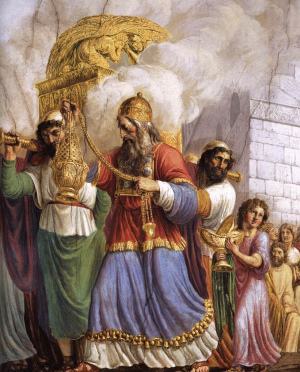The Ark of the Covenant experienced a fascinating history since it was commanded that the children of Israel make the sacred container at Mount Sinai (Exodus 25:10 - 22). During the Israelites forty years in the wilderness the ark preceded the people whenever they traveled from place to place (Numbers 10:33, Joshua 3:3).
Leading the way into the Promised Land, under Joshua, the priests carried the Ark of God unto the river Jordan. The moment their feet touched the river, its waters were miraculously divided and they walked, on dry ground, to the middle of the stream! They stayed in the middle of the dry bed until the entire company of Israelites crossed over the Jordan, in 1405 B.C., to begin claiming their inheritance (Joshua 3:14 - 17).
Taken and Returned!
The ark and its tabernacle were placed in Shiloh in 1398 B.C., the same year Joshua had lots cast for the remaining parts of the Promised Land (Joshua 18:1). The Ark remained in the city until 1085 B.C., the year the prophet Samuel began to judge Israel.

It was in the fateful year of 1085 that Israel, once again, warred against their greatest enemy the Philistines. In their initial engagement God's people lost 4,000 fighting men (1Samuel 4). Baffled as to why they lost, the Israelites make the foolish decision to bring the ark onto the battlefield. The Philistines again route the people and take the ark as a trophy of war (verses 10 - 11)!
The Philistines soon regret the day they took Israel's national treasure. God (rather humorously) punishes them for roughly seven months with painful emerods (hemorrhoids) until they willingly give back the ark to those living in Beth-shemesh (1Samuel 6).
After the men in Bethshemesh foolishly looked inside the Ark of the Covenant, and were killed by the Lord for doing so (1Samuel 6:19), it was taken to Kirjath-jearim (1Samuel 6:21 - 7:2). It then stayed in this location until the time of David.
Home to Jerusalem
David, after being accepted and anointed king over all Israel in c. 1003 B.C., attacks and conquers the city of Jebus (1Chronicles 11:4) and renames it Jerusalem. Desiring the ark to be with him in his new capital, he sets out to move it from Kirjath-jearim (1Chronicles 13:5).
David commits a grave error, however, in transporting the ark to its new home. His mistake costs someone being killed directly by God (2Samuel 6:3 - 7). Three months later the Levites properly move the ark to the city of Jerusalem (2Samuel 6:12 - 16). It stays in the city during David's entire reign.
The Temple Is Built!
King Solomon completed Jerusalem's magnificent temple in c. 959 - 958 B.C. At the temple's dedication ceremony, he has the priests bring the ark to its new home. It is housed in a dedicated part of the building known as the Holy of Holies. The area is a 20 cubit (34 feet or 10.36 meter) cubed-shaped room (1Kings 6:16), overlaid with gold, where God's presence would be manifested.
After the priests placed the ark in the Holy of Holies, the entire temple is filled with a cloud that represents God's glorious presence (1Kings 8:10 - 11)!
Not much is recorded about the Ark after its installment at the temple. One Scripture, however, does allude to it being moved from the Holy of Holies. It may have been moved due to temple repairs or possibly to protect it from evil kings like Manasseh and Amon. It was returned to its rightful place at the time of King Josiah (2Chronicles 35:1 - 3).
Does It Still Exist?
God prophesied, 100+ years before the temple's destruction, that all its treasures would be taken to Babylon (2Kings 20:17). This event did take place under King Nebuchadnezzar, who pillaged the temple (including the ark) and took them back to Babylon.
And he (the king of Babylon) carried out from there all the treasures of the house of the Lord, and the treasures of the king’s house, and cut in pieces all the vessels of gold which Solomon king of Israel had made in the temple of the Lord, as the Lord had said. (2Kings 24:13).
Interestingly, the destruction of God's house of prayer took place in 586 B.C. on the Hebrew date of Ab 9 (Tuesday, July 17). The Eternal would later allow the Romans, under Titus, to also pillage and level the temple on Ab 9 (Saturday, August 4) in 70 A.D.
The Ark of the Covenant was almost certainly disassembled and its precious metals melted and reused by the Babylonians. Years later God allowed captive Jews to return to Jerusalem and rebuild both the city and the temple.
Although the Jews were given back many precious temple items taken by the Babylonians, the Ark of God was not among those treasures they received (see Ezra 1:7 as well as chapters 5 - 6).